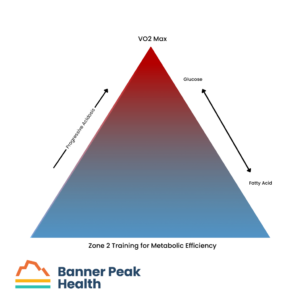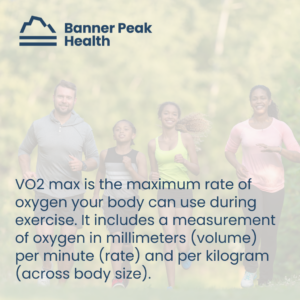More people are discovering the importance of VO2 max and have begun using wearables like Garmin, Oura Ring, and Apple Watch to monitor it. But what happens if your VO2 max suddenly drops?
In this blog post, I’ll explain VO2 max and its importance. I’ll also answer the questions, “Why is my VO2 max going down?” and “How can I increase it?”
What Is VO2 Max and Why Is It Important?
VO2 max is the maximum rate of oxygen your body can use during exercise. It includes a measurement of oxygen in millimeters (volume) per minute (rate) and per kilogram (across body size).
VO2 max assesses the health of your entire cardiovascular system, including heart, lung, and blood vessel function. It even evaluates muscle cells down to their mitochondria. It’s an extremely accurate predictor of all-cause mortality.
Why Is My VO2 Max Going Down?
A decline in VO2 max can alarm people who exercise regularly. Here are a few reasons you may notice a reduction in your VO2 max:
- Anyone can have a bad day. Various reasons include a lack of sleep, over-exercising, illness, or stress.
- A medium-term decline over weeks may occur due to weight gain or insulin resistance (more on this in a bit).
- Age-related declines.
- Anemia.
How to Improve Your VO2 Max
Improving your VO2 max comes back to how you measure it.
The gold standard for measuring your VO2 max is a stress test, which involves running on a treadmill or riding an exercise bike to complete exhaustion while having your breath monitored for changes in oxygen concentration.
Many assume that to improve your VO2 max, you need to put yourself under intense mental and physical stress to be valuable.
Evidence does support that HIIT (high-intensity interval training) can improve your VO2 max; however, it’s not the only way. You should also participate in Zone 2 training.
How can large amounts of time spent plodding along at a conversational pace help you maximize your ability to go so fast you can barely breathe? The answer to this paradox involves understanding the metabolic efficacy of Zone 2.
For exercise, our muscles use two fuels as energy: fatty acids and glucose. At slower speeds, we metabolize fatty acids and can go all day. Fatty acids are “clean fuel.”
At faster speeds, we metabolize progressively more glucose. The process creates progressively more acidosis and causes symptoms including increased heart rate, shortness of breath, and burning muscles. Our struggle with acidosis is why we can’t maintain faster paces as long as slower ones.
Therefore, the longer you can go while being fueled by fatty acids, the greater the speed you can reach before your body switches fuel sources, which causes you to feel the effects of acidosis.
 What About Genetics?
What About Genetics?
Although we all start with different genetic propensities for VO2 max, we’re all capable of improving it with a concerted effort.
No matter our age or genetic background, there is room for improvement.
Don’t Panic
As more people learn about VO2 max’s importance, it’s crucial to understand that current wearables aren’t advanced enough to accurately measure VO2 max. I track mine with both a Garmin device on my bike and the gold standard. The Garmin device varies with up to a 25% error.
So, if you look at your wearable and see a result that makes you ask, “Why is my VO2 max going down?” don’t panic. Periodically check your wearable against the gold standard for a correlation.
If you’re a Banner Peak Health member, we’re happy to help. Schedule an appointment today.

Barry Rotman, MD
For over 30 years in medicine, Dr. Rotman has dedicated himself to excellence. With patients’ health as his top priority, he opened his own concierge medical practice in 2007 to practice medicine in a way that lets him truly serve their best interests.




